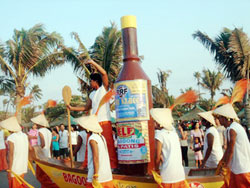Lingayen, famous for bangus, bocayo and bagoong – otherwise known as the 3 Bs – recently held its third Bagoong Festival.
Bagoong is a salted fish-paste delicacy well loved by Filipinos as a dip, side dish, or main viand (stewed with pork and other meats). Every Filipino household is well-stacked with this condiment. It is best known as manggang hilaw’s binary pair, because its saltiness neutralizes the green fruit’s tartness. A popular Filipino fiesta dish, kare-kare, cannot be eaten without bagoong on the side.
The bagoong manufacturing process begins with mixing measured amounts of fish, shrimp and brine. The blend is then kept and fermented up to 12 months until bubbles form and begins to waft its characteristic strong odor.
JB Bagoong owner Daniel Bernal Jr. traces the origin of the bagoong to his father, Daniel Sr., a fisherman. “He sold fish in the market or from house to house. One time, he put unsold fish in a jar and filled it with salt so he could preserve them for frying later,” he recounts. Unfortunately or fortunately, he forgot about the jar “ … and when he saw it again several weeks later, all the fish had decomposed. But the jar’s contents smelled and tasted good.”
Lingayen has 56 bagoong processors, wholesalers and retailers, based on records of the Departent Trade and Industry provincial office in Dagupan City.
Most producers are small or medium-scale businesses, with 50 to 100 workers, producing an average of 1,500 boxes of the condiment monthly. Some of the output is exported to places in the United States, like Hawaii and California, where there is a thriving Filipino population.
The festival was first organized in April 2011 and was later moved to January as part of Lingayen’s fiesta celebration in honor of its patron.
Photo: from THE ART OF MEL CASIPIT: Pangasinan Festivalsmelcasipit.blogspot.com

